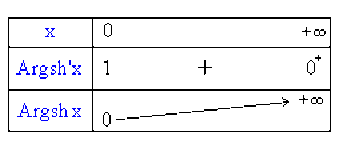Fonction Argument sinus hyperbolique de x
Définition :
L'application \(\textrm{sh}\) : \(\mathbb{R} \to \mathbb{R}\) continue et strictement croissante admet une fonction réciproque notée \(\textrm{Argsh}\) : \(\mathbb{R} \to \mathbb{R}\)
\(y = \textrm{Argsh } x \Leftrightarrow x = \textrm{sh }y\)
\(x \in \mathbb{R} \textrm{ et } y \in \mathbb{R}\)
\(\begin{array}{llr} \textrm{sh } (\textrm{Argsh }x) = x & \forall x \in \mathbb{R} \\ \textrm{ch } (\textrm{Argsh }x) = \sqrt{1+x^{2}} \qquad& \forall x \in \mathbb{R} \\\textrm{th } (\textrm{Argsh }x) = \frac{x}{\sqrt{1+x^{2}}} \qquad& \forall x \in \mathbb{R} \\ \textrm{coth } (\textrm{Argsh }x) = \frac{\sqrt{1+x^{2}}}{x} \qquad& \forall x \in \mathbb{R}^{\ast}\end{array}\)
fonction impaire, d'où étude sur \(D_{e} = [0, + \infty [\).
fonction dérivable sur \(D_{e}\) et :
\(\textrm{Argsh'}x = \frac{1}{\textrm{sh}'(\textrm{Argsh }x)} = \frac{1}{\textrm{ch}(\textrm{Argsh }x)} = \frac{1}{\sqrt{x^{2} + 1}}>0\)
donc fonction croissante sur \(D_{e}\).
tableau de variation :

Représentation graphique de \(\textrm{Argsh }x\)

Expression logarithmique de \(\textrm{Argsh }x\)
\(\forall x \in \mathbb{R} \qquad \textrm{Argsh }x = \ln \left(x + \sqrt{x^{2} + 1}\right)\)
Démonstration :
\(\forall (x, y) \in \mathbb{R}^{2} \qquad y = \textrm{Argsh }x \Leftrightarrow x = \textrm{sh }y \Leftrightarrow \textrm{ch }y = + \sqrt{\textrm{sh}^{2}y + 1} = \sqrt{x^{2} + 1}\)
et comme
\(e^{y} = \textrm{sh }y + \textrm{ch }y = x + \sqrt{x^{2} + 1}\)
\(y = \ln \left(x+\sqrt{x^{2} + 1}\right)\)
Remarque :
Pour \(y \in \mathbb{R}\), \(\textrm{ch }y\) est positif, d'où la solution retenue \(\textrm{ch }y = (\textrm{sh}^{2}y + 1)^{ 1/2}\) .
On retrouve la fonction dérivée :
\(\left[\ln\left(x+ \sqrt{x^{2}+1}\right)\right]' = \frac{1+\frac{x}{\sqrt{x^{2} + 1}}}{x + \sqrt{x^{2} + 1}} = \frac{1}{\sqrt{x^{2} + 1}} = \textrm{Argsh}' x\)